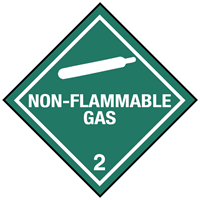
 Print
Print
Chemical Datasheet
CHLOROTRIFLUOROMETHANE |

|
Chemical Identifiers
| CAS Number |
UN/NA Number |
DOT Hazard Label |
USCG CHRIS Code |
- 75-72-9

|
|
|
|
| NIOSH Pocket Guide |
International Chem Safety Card |
|
none
|
|
NFPA 704
data unavailable
General Description
Chlorotrifluoromethane is a colorless odorless gas. It is shipped as a liquefied gas under its own vapor pressure. It is noncombustible. It can asphyxiate by the displacement of air. Contact with the liquid can cause frostbite. Exposure of the container to prolonged heat or fire may cause it to rupture violently and rocket.
Hazards
Reactivity Alerts
none
Air & Water Reactions
No rapid reaction with air. No rapid reaction with water.
Fire Hazard
Special Hazards of Combustion Products: Toxic fumes of Cl and F (USCG, 1999)
Health Hazard
Exposure may cause nausea, dizziness, and headache, and rapid suffocation. Contact with skin may cause frostbite. (USCG, 1999)
Reactivity Profile
The reaction of aluminum with various halogenated hydrocarbons produces a self-sustaining reaction with sufficient heat to melt aluminum pieces, examples of other halogenated hydrocarbons are fluorotrichloromethane, dichlorodifluoromethane, chlorodifluoromethane, tetrafluoromethane. The vigor of the reaction appears to be dependent on the combined degree of fluorination and the vapor pressure, [Chem. Eng. News 39(27):44(1961)].
Belongs to the Following Reactive Group(s)
- Fluorinated Organic Compounds
Potentially Incompatible Absorbents
No information available.
Response Recommendations
Isolation and Evacuation
Excerpt from ERG Guide 126 [Gases - Compressed or Liquefied (Including Refrigerant Gases)]:
IMMEDIATE PRECAUTIONARY MEASURE: Isolate spill or leak area for at least 100 meters (330 feet) in all directions.
LARGE SPILL: Consider initial downwind evacuation for at least 500 meters (1/3 mile).
FIRE: If tank, rail tank car or highway tank is involved in a fire, ISOLATE for 800 meters (1/2 mile) in all directions; also, consider initial evacuation for 800 meters (1/2 mile) in all directions. (ERG, 2024)
Firefighting
Excerpt from ERG Guide 126 [Gases - Compressed or Liquefied (Including Refrigerant Gases)]:
Use extinguishing agent suitable for type of surrounding fire.
SMALL FIRE: Dry chemical or CO2.
LARGE FIRE: Water spray, fog or regular foam. If it can be done safely, move undamaged containers away from the area around the fire. Damaged cylinders should be handled only by specialists.
FIRE INVOLVING TANKS: Fight fire from maximum distance or use unmanned master stream devices or monitor nozzles. Cool containers with flooding quantities of water until well after fire is out. Do not direct water at source of leak or safety devices; icing may occur. Withdraw immediately in case of rising sound from venting safety devices or discoloration of tank. ALWAYS stay away from tanks in direct contact with flames. Some of these materials, if spilled, may evaporate leaving a flammable residue. (ERG, 2024)
Non-Fire Response
Excerpt from ERG Guide 126 [Gases - Compressed or Liquefied (Including Refrigerant Gases)]:
Do not touch or walk through spilled material. Stop leak if you can do it without risk. Do not direct water at spill or source of leak. Use water spray to reduce vapors or divert vapor cloud drift. Avoid allowing water runoff to contact spilled material. If possible, turn leaking containers so that gas escapes rather than liquid. Prevent entry into waterways, sewers, basements or confined areas. Allow substance to evaporate. Ventilate the area. (ERG, 2024)
Protective Clothing
Approved respirator, safety goggles, rubber gloves, safety shoes. (USCG, 1999)
DuPont Tychem® Suit Fabrics
No information available.
First Aid
INHALATION: Remove to fresh air. If breathing has stopped, give artificial respiration. If breathing is difficult, give oxygen.
SKIN: Wash affected areas with warm water. DO NOT USE HOT WATER. (USCG, 1999)
Physical Properties
Flash Point: data unavailable
Lower Explosive Limit (LEL): data unavailable
Upper Explosive Limit (UEL): data unavailable
Autoignition Temperature: data unavailable
Melting Point:
-294°F
(USCG, 1999)
Vapor Pressure:
24816 mmHg
(USCG, 1999)
Vapor Density (Relative to Air):
1.298
at -22°F
(USCG, 1999)
- Heavier than air; will sink
Specific Gravity: data unavailable
Boiling Point:
-114°F
at 760 mmHg
(USCG, 1999)
Molecular Weight:
104.46
(USCG, 1999)
Water Solubility: data unavailable
Ionization Energy/Potential: data unavailable
IDLH: data unavailable
AEGLs (Acute Exposure Guideline Levels)
No AEGL information available.
ERPGs (Emergency Response Planning Guidelines)
No ERPG information available.
PACs (Protective Action Criteria)
| Chemical |
PAC-1 |
PAC-2 |
PAC-3 |
| Chlorotrifluoromethane; (CFC-13) (75-72-9)
|
3000 ppm |
33000 ppm |
200000 ppm |
(DOE, 2024)
Regulatory Information
EPA Consolidated List of Lists
| Regulatory Name |
CAS Number/
313 Category Code |
EPCRA 302
EHS TPQ |
EPCRA 304
EHS RQ |
CERCLA RQ |
EPCRA 313
TRI |
RCRA
Code |
CAA 112(r)
RMP TQ |
| CFC-13 |
75-72-9 |
|
|
|
X |
|
|
| Chlorotrifluoromethane |
75-72-9 |
|
|
|
313 |
|
|
(EPA List of Lists, 2024)
CISA Chemical Facility Anti-Terrorism Standards (CFATS)
No regulatory information available.
OSHA Process Safety Management (PSM) Standard List
No regulatory information available.
Alternate Chemical Names
- ARCTON 3
- CFC 13
- CFC-13
- CHLOROTRIFLUOROMETHANE
- F 13
- F-13
- FC 13
- FKW 13
- FREON 13
- FREON R 13
- FRIGEN 13
- GENETRON 13
- KHLADON 13
- MONOCHLOROTRIFLUOROMETHANE
- R 13
- R 13 (REFRIGERANT)
- REFRIGERANT 13
- REFRIGERANT GAS R-13
- REFRIGERANT R 13
- TRIFLUOROCHLOROMETHANE
- TRIFLUOROMETHYL CHLORIDE
- TRIFLUOROMONOCHLOROCARBON


 Print
Print
